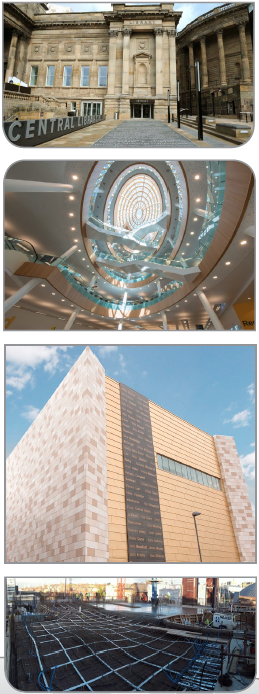 Liverpool Central Library – Post-tensioned Concrete Floor
Liverpool Central Library – Post-tensioned Concrete Floor
Architect
Austin-Smith:Lord LLP
Structural Engineer
RoC Consulting
Main Contractor
Sheperd Construction
Frame Contractor
Heyrod Construction
Works Completed
September 2012
Liverpool Central Library was Britain’s first purpose built public lending library when it opened in 1860. In 1879, the library was extended by the addition of the Picton Library, a magnificent colonnaded rotunda housing the domed Picton Reading Room, and further extended with the addition of the Hornby Library in 1906. The public have not been able to access these two Grade II* historic spaces for decades and bringing them back into the public realm was an important part of the project.
The Main Library building was bombed in the World War II and rebuilt behind the original stone façade in the 1950s. All of the 1950s construction has now been replaced with new construction that sits sympathetically with the original structures.
The library is approached by a literary carpet, a stone pathway engraved with quotes from famous pieces of literature. Once inside, the visitor is greeted with a narrow vestibule space that extends the full height of the building and is flooded with light from above. The interior is a self-supporting concrete box that has been pulled away from the historic facade. The vestibule forming the gap between the two ensures that the facade is not load-bearing. It also enables the new internal levels to be freed from the restriction imposed by the position of the existing windows.
The new concrete frame comprises five floors of post-tensioned concrete, 250mm thick. The floor plate measures 41 by 30m and the grid varies up to 10.3 x 7.0m. Each level contains an elliptical hole which forms the central atrium which allows natural light to bathe the interior of the building. The slabs are stressed by the 4B15 bonded tendon system.
The New Archive Building, at the back of the site, is an airtight, climate-controlled six-storey structure that contains Liverpool’s archives which stretch back over 800 years. It has 14km of mobile racking shelf which impose a minimum of 12kN/mÇ, and in some places 14kN/mÇ, of loading onto the floors. The deflection tolerance stipulated by the racking supplier, Bruynzeel, was a stringent 1mm in 1m and +/-3mm overall. Freyssinet adopted 600mm deep beams to span the 11m direction and 250/300 thick slabs to span the 6/8m direction. Slabs and beams were stressed with the 4B15 bonded system again, the 2000mm wide beams containing eight such tendons.
The project was executed under a í55M PFI contract which included the full renovation of the historic spaces, as well as construction of the new. The library was re-opened by HRH The Earl of Wessex in September 2013.
